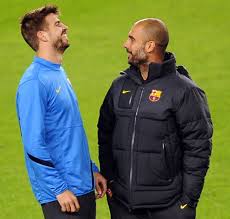Dougherty: For the young player, details matter
 I’ve been thinking a lot about summer lately. Not just because of the frigid temperatures and darkness that comes way, way too early. Well, partly because of that.
I’ve been thinking a lot about summer lately. Not just because of the frigid temperatures and darkness that comes way, way too early. Well, partly because of that.
But I’ve been thinking about summer because this is when players begin thinking about which summer soccer camps they’ll be attending. And I’m reminded how frustrated I get when, as a college camp coach, I see how poorly many of our youth players are trained in some of the fundamentals of the game of soccer.
I generally work at two college camps each summer, and each year I’m left shaking my head at the mistakes players routinely make – mistakes they should not make when they are in their middle school and high school years. But each summer it’s the same.
One example: receiving the ball. If I had a dollar for every player I’ve seen tangle their legs up in a pretzel to receive a pass simply because they didn’t want to take a step or two to receive it across their body, I could build D.C. United’s new stadium at Buzzard’s Point and still have money left over for parking, a bag of peanuts and a Coke Zero.
Right-footed players would often cross their right leg over the left and receive a pass with the outside of the right foot, instead of simply stepping back, allowing the ball to cross in front of them, and collect it
with the inside of the second foot. The latter technique is easier, smoother, more efficient, and …. well, just the right way to do it.
+Read: How to be intentional with your college commitment
But even after an entire morning of demonstrating how to properly receive a pass across the body and games designed to encourage that skill under pressure, players quickly revert to their old – and wrong – ways. Head-shakingly baffling.
Then there’s crossing.
Granted, good crossing is not easy, and even players in the Premier League – perhaps the most cross-friendly league in the world – get it wrong. But with some practice it can be learned.
The key elements: the final touch before the cross should be slightly inside; the plant foot needs to be toward the middle of the field; and the hips should be turned in, not facing the end line. If the situation prohibits those steps from being done, cut the ball back and pass back to a teammate.
Yet many young players these days are seemingly unaware of these basics. Time and again I’ve seen players send their crosses into the side netting, behind the net or into parking lots.
Finally, there’s shooting. For some players, no matter how often they are told “accuracy BEFORE power,” they hear “power BEFORE accuracy.” Perhaps it’s the SportsCenter effect – the desire to get that memorable upper-ninety frozen rope they’ll remember forever – or at least be the talk of the cafeteria dinner table that night.
Unfortunately, the quest for that magic goal often results in a field goal well above the crossbar or, even worse, a shank that ends up with a throw-in. Some would say, “unlucky!” No, luck has nothing to do with it. It’s poor technique.
Coaches, I’m looking at you. And me.
Technique matters. In the closing moments in a game, when fatigue has set in and goal-scoring chances are critical, it is technique that players need to make the move, connect the pass, and put the shot on frame.
+Read: How the business of youth soccer changed the player-coach relationship
 Yet too often, youth coaches fail to take advantage of those crucial teaching moments at practice. This is particularly critical at the younger ages – U9 through U14 – when players are learning new skills and habits they will carry with them throughout their playing days. Identifying, and correcting, technical mistakes in young players is, to me, one of the most important things coaches of these players can do.
Yet too often, youth coaches fail to take advantage of those crucial teaching moments at practice. This is particularly critical at the younger ages – U9 through U14 – when players are learning new skills and habits they will carry with them throughout their playing days. Identifying, and correcting, technical mistakes in young players is, to me, one of the most important things coaches of these players can do.
The challenge for coaches is to be consistent in teaching the skill, and demanding the players do it right. “Not sometimes, not most of the time – all of the time,” my teams over the years have heard me say. Spotting the mistake, taking a moment to correct it, and then quickly moving on is critical.
My favorite example is Barcelona, particularly the Pep Guardiola teams. Seldom did you see a Barca player lazily cross their legs to receive a ball with the outside of the foot. Ninety-eight percent of the time, I would argue, Barca players – under pressure or not – would carry the ball across their bodies, opening their hips to see more of the field and create new passing, dribbling or shooting opportunities.
And when it came to shooting, seldom did a Barca player put one over the crossbar. Shots were made with the instep or inside of the foot, and they much preferred to “tuck it in” – accuracy – than to blast it on goal – power.
Repetition and attention to detail. Go on YouTube and find a Pep training session with Barca or Bayern Munich and you will clearly see how he demands things are done right, all of the time.
Can we treat our young players like Bayern or Barca? Of course not. But the lesson is clear – attention to detail, consistently correcting mistakes when you see them, and applauding players when they do it right all make a dramatic difference in a player’s ability to play the game at a high level.
SOCCERWIRE MARKETPLACE
- Start the Season Strong at Loudoun Premier Cup!
- 50th Annual Rael Vodicka Memorial Tournament
- Soccer Marketing Internships at The St. James FC
- Job Opening: The St. James FC Goalkeeper Academy Coach
- Full-Time Director of Goalkeeping for The St. James FC
- visitRaleigh.com Showcase Series 2025, hosted by NCFC Youth
- Join Official Elite Summer Soccer Camps with Europe’s Top Pro Clubs!
- OFFICIAL BAYERN MUNICH SUMMER CAMPS U.S.
- OFFICIAL FC BARCELONA CAMPS U.S.
- The Cup San Diego - Hosted by Legends FC











